Key Points:
- The snake with the biggest eyes in the world is the large-eyed green tree snake, native to Africa. Besides being venomous, its other defense tactic is to inflate its throat to make it look bigger to predators.
- The rough-scaled bush viper is known for its excessively keeled dorsal scales that make it appear bristly. It communicates and perceives heavily through eyesight but also touch and olfactory senses.
- The large-eyed pit viper, also known as the green pit viper, has very large eyes that are quite sinister in appearance. It is commonly found in Thailand and throughout Southeast Asia.
Imagine you are a snake. You’re creeping down the path, trailed by a long, slithering body. You don’t have any ears, and you can’t blink, even if your eyes are enormous and well-developed. You’re continuously flicking your tongue, which keeps you informed about everything that’s going on around you, specifically the fragrance of that delicious mouse you’ve been waiting for days.
In a world of over 3,000 different snake species, it’s impossible to understand them all. Snakes are legless reptiles with incredibly strong bodies for a variety of functions. In this article, however, we’ll look at some of the world’s largest-eyed snakes in the hopes of casting some light on these fascinating but unfairly treated creatures. Below, we will explore 10 snakes with the biggest eyes in the world.
But before we dive in, let’s answer a question that may be on your mind. Why do some snakes have large eyes, while others have small ones? The size of the eye is based on whether the snake is diurnal or nocturnal. Snakes that go about their business in the light of day have smaller eyes with round pupils to protect them from extreme sunlight, while nocturnal snakes have elliptical pupils in their large eyes to maximize the light available at night.

10. Common Big-Eyed Snake
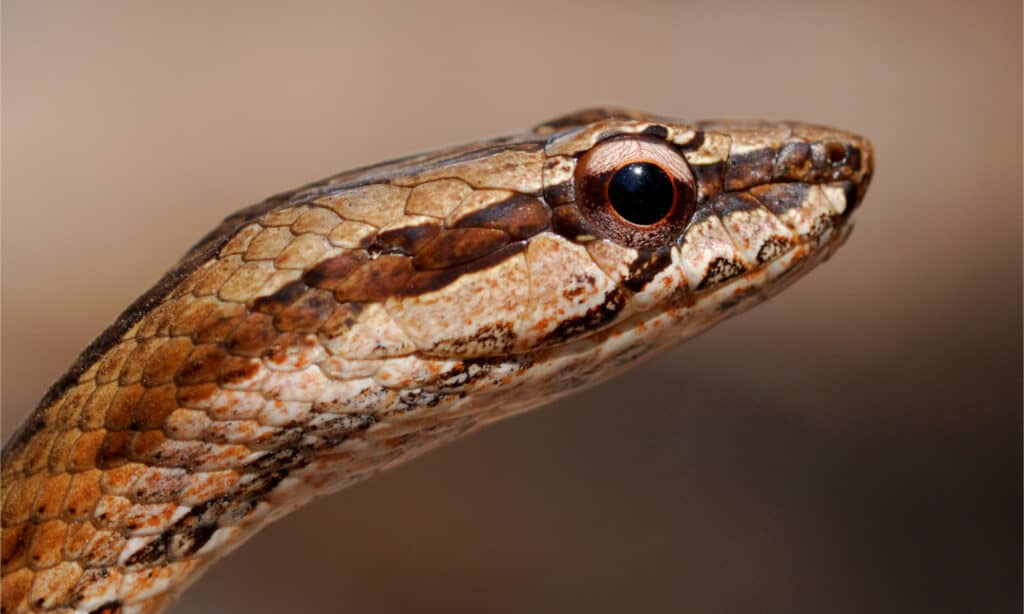
The common bug-eyed snake has huge and expressive black eyes.
©Hugh Lansdown/Shutterstock.com
Mimophis mahfalensis, popularly known as the common big-eyed snake, belongs to the Lamprophiidae family of snakes. It is native to Madagascar and thrives in the center and southern regions of the island. The northern population is a distinct species known as Mimophis occultus. As its name implies, this snake has huge and expressive black eyes. It’s also one of the most docile snakes, biting only in dangerous situations. It is diurnal and is frequently seen on the ground in the early morning, searching for small mammals such as sand iguanas and other reptiles. It uses a targeted bite to kill its prey and secretes a small amount of poison from expanded teeth that lay far back in the jaw, directly under the eyes. Its venom is fatal to other animals but not to humans.
9. Boomslang Snake

Male
boomslangs
have a brown tint to their green bodies with black or blue outlines.
©iStock.com/FroeMic
The boomslang is a moderately slender, venomous snake belonging to the Colubridae family. It’s endemic in Sub-Saharan Africa. South Africa, Eswatini, Mozambique, Botswana, Namibia, and northern Sub-Sahara Africa are home to this species. Boomslang snakes have strikingly huge eyes, while juvenile boomslangs have stunning iridescent green eyes. Their body and eye colors are highly changeable, and they have superb camouflage. This snake waits for chameleons and birds in a bush or tree when hunting. The boomslang inflates its neck, revealing the dark skin between the scales, and then strikes its prey. The fangs are situated far forward in the mouth, even though it is rear-fanged. In modest amounts, its venom causes hemorrhages and can be lethal to humans.
8. Large-Eyed Pit Viper
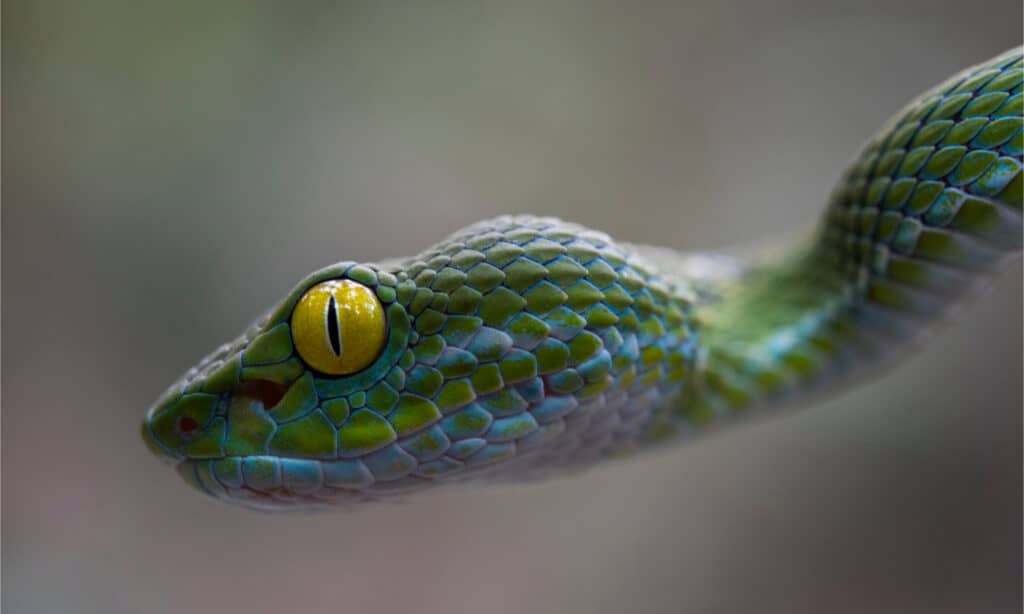
The large-eyed pit viper has enormous eyes visible in adults.
©Ali Bernie Buga-ay/Shutterstock.com
Trimeresurus macrops is a Southeast Asian poisonous pit viper species. Large-eyed pit viper and green pit viper are two common names for this snake. In Thailand, it’s a common species that thrives in suitable habitats. The comparatively enormous size of its eyes, which is especially visible in adult specimens and to which the specific name, macrops, refers, distinguishes it from other pit vipers. The eyes of a pit viper give off a frightening impression, as though it’s ready to strike at any moment. It has a lethal bite that we should avoid at all costs. Bites can cause excruciating pain, inflammation, flesh necrosis, and, in certain circumstances, severe systemic hemorrhage. Although fatalities are uncommon, local harm can be lasting. If a pit viper bites you, seek medical attention as soon as possible.
7. Yellow-Faced Whip Snake
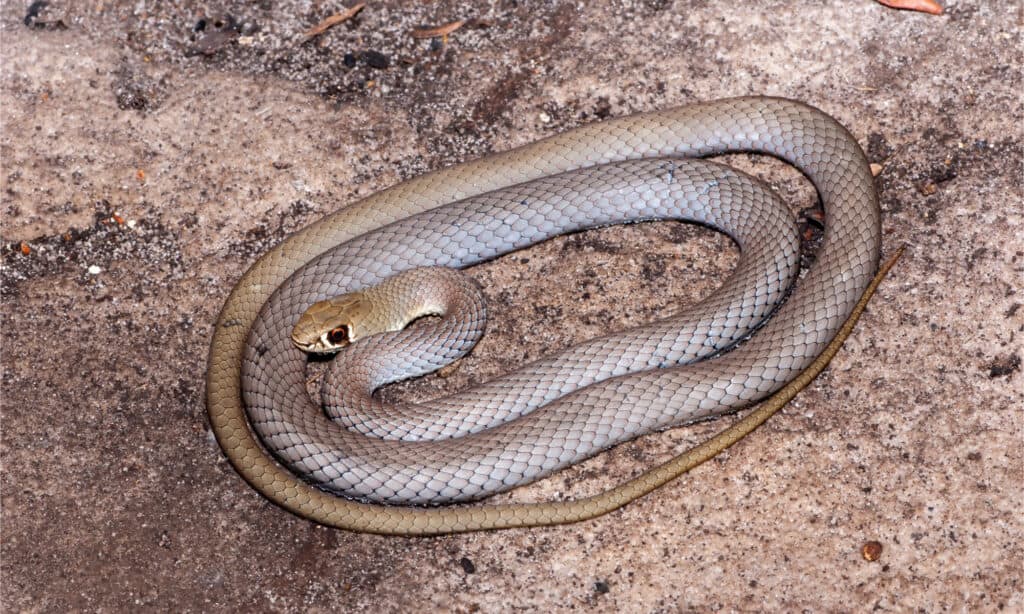
Belonging to the Elapidae family, the yellow-faced whip snake has massive eyes with a pale ring around it.
©Ken Griffiths/Shutterstock.com
The yellow-faced whip snake (Demansia psammophis) is a poisonous snake belonging to the Elapidae family, which includes many hazardous snakes. It is indigenous to Australia, and found in different environments, from coastal edges to desert scrubland in the interior. Its color ranges from mild bluish-grey to light olive green, with a reddish tinge on the neck and front third of the back. The whip snake’s eye is massive and has a pale ring around it. A black comma-shaped marking runs beneath the eye, and a dark, pale-edged line runs between the nostrils on the tip of the snout. Yellow-faced whip snakes are diurnal reptiles that move quickly and have a nervous temperament. They are always alert and immediately flee when startled. During the winter, the Yellow Whip Snake goes into bloom.
6. Big-Eyed Ratsnake
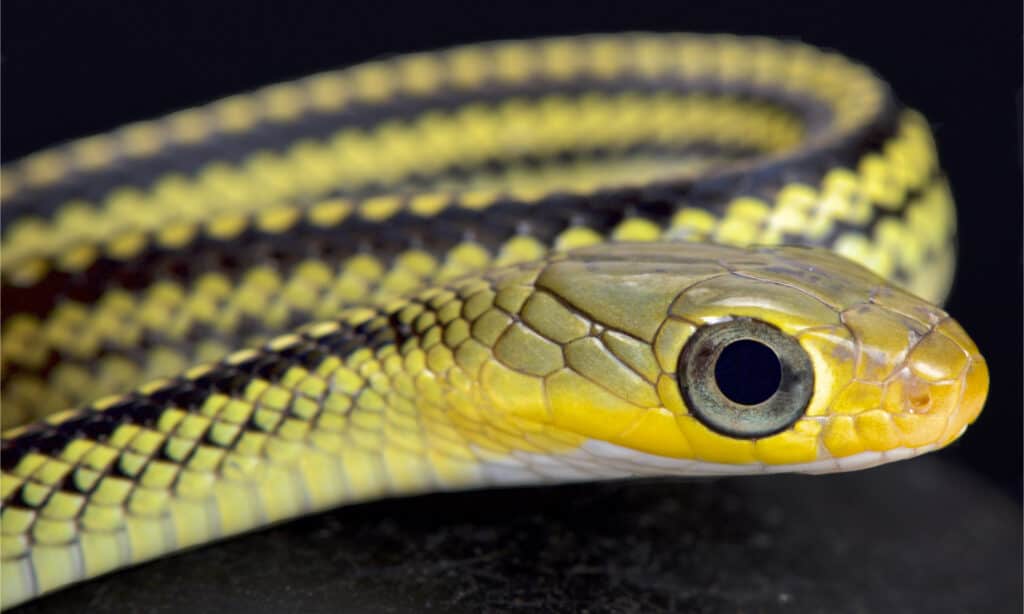
The big-eyed rat snake’s huge eyes make it difficult to be studied and trapped.
©reptiles4all/Shutterstock.com
Ptyas is a colubrid snake genus. It is one of the numerous colubrid genera commonly known as rat snakes. They are native throughout Taiwan but more widespread in the north. Their eyes are enormous, with iris hues ranging from dark gray to black, mottled dirty yellow to tan, and a spherical, black pupil bordered by a filthy yellow ring. They are diurnal and terrestrial snakes that inhabit grasslands, woodlands, and farmland. This snake feeds extensively on fish, frogs, lizards, snakes, birds, and mice. It is a nervous and agile snake, prone to sudden irregular movements when cornered. It is Asia’s fastest snake, and thanks to its huge eyes, it’s also one of the most expressive — a combination that makes it hard to study and even more difficult to trap.
5. Blunt-Headed Tree Snake
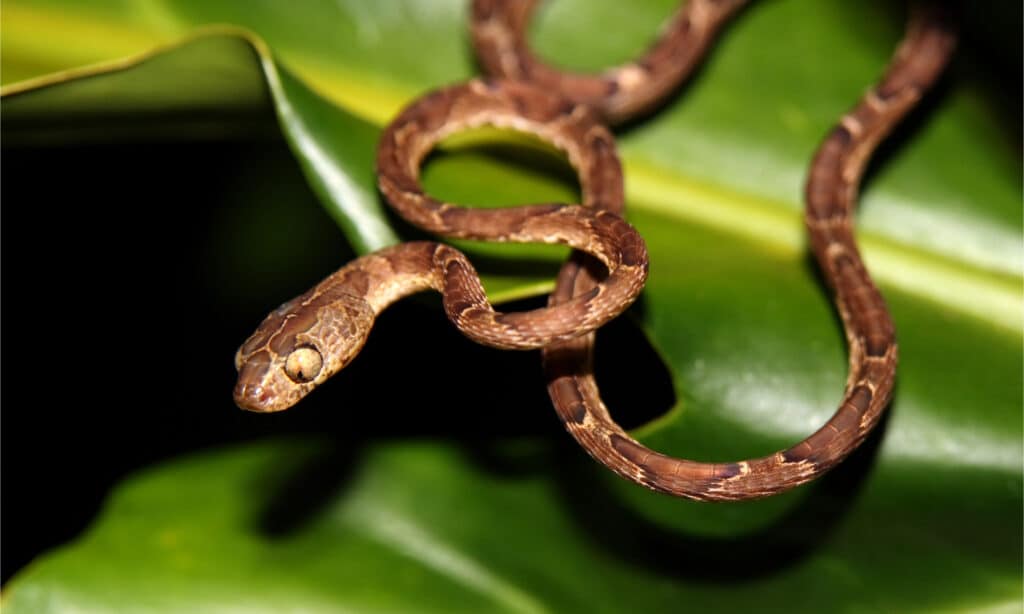
The blunt-head tree snake is a mildly venomous snake with big eyes.
©Ryan M. Bolton/Shutterstock.com
Imantodes cenchoa (also known as the blunt-head tree snake) is a mildly venomous rear-fanged snake in the Colubridae family. Mexico, Central America, and South America are home to the species. Blunt-headed tree snakes have long, slender bodies with long necks and big heads. Their eyes, which have vertical pupils, take up about a quarter of the length of their head and protrude from the side, allowing the animal to look downward. The arboreal nature of the blunt head tree snake is evident. It is particularly prevalent in low-growing plants like coffee trees and bromeliads and favors cold, moist environments like wet forests and rainforests. Blunt-headed tree snakes are nocturnal carnivores, which means they hunt at night. They usually eat the eggs of tiny lizards, frogs, and other reptiles. They have a rear fang and are somewhat poisonous, although they are not deadly to humans.
4. Banded Cat-Eyed Snake
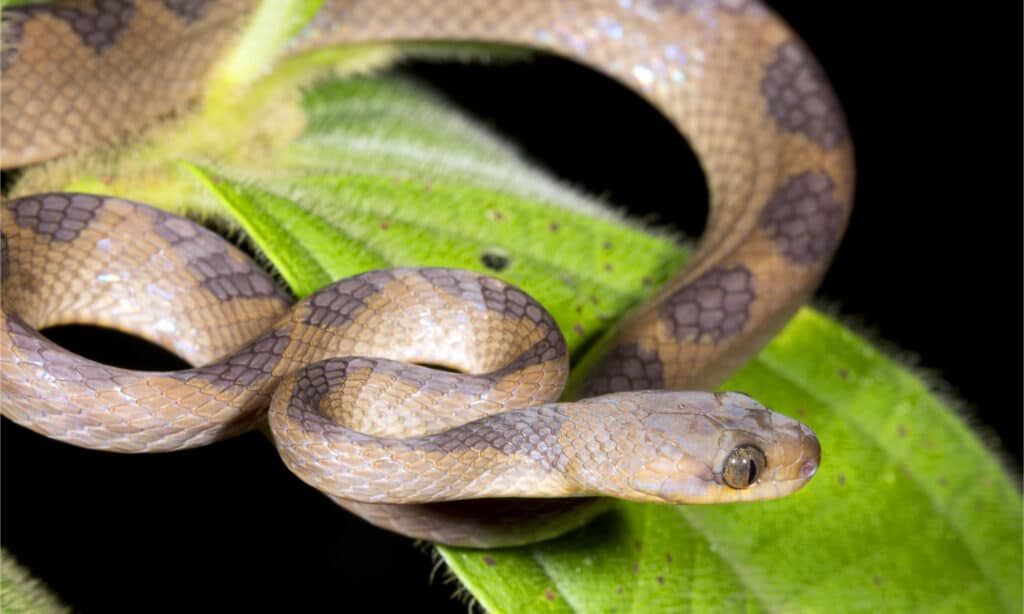
Banded cat-eyed snakes get their name from their big emerald eyes.
©Dr Morley Read/Shutterstock.com
The banded cat-eyed snake (Leptodeira annulata) is a small, mildly venomous colubrid snake that thrives in the New World. Dry and moist forests, forest borders, and regions near swamps and marshes are all home to the banded cat-eyed snake. The term “cat-eyed snake” comes from their big emerald eyes with vertical, elliptically-shaped pupils (cat-like). They are nocturnal, and they hunt and feed in trees and on the ground. These snakes secrete a weak venom and have a pair of enlarged, grooved teeth at the back of each upper jaw, affecting the snake’s natural prey, mainly frogs and small lizards. When handled, the snake rarely bites humans, but when it does, the venom has a moderate effect on most people (faint irritating/itching sensation with slight swelling).
3. Green Whip Snake
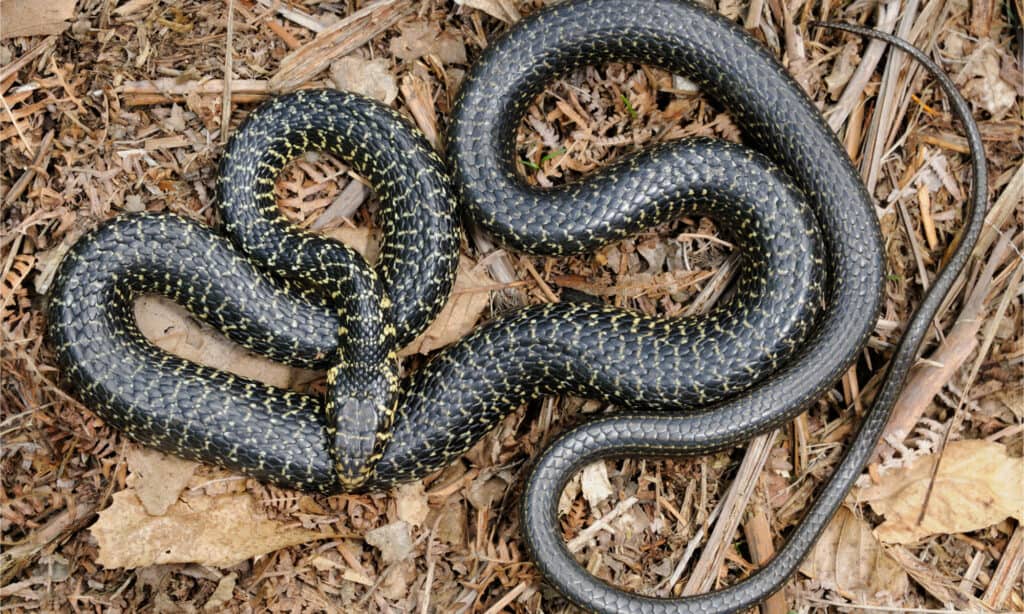
Also known as the western whip snake, the green whip snake thrives in southern Thailand.
©Matteo photos/Shutterstock.com
The green whip snake, also known as the western whip snake (Hierophis viridiflavus), belongs to the Colubridae family of snakes. They thrive from southern Thailand and southern Myanmar, through Peninsular Malaysia and Singapore, to Sumatra and Java. The Malayan or Big-Eye Green Whip Snake is a somewhat poisonous but gentle snake that lives in primary and mature secondary forests, often on vegetation near forest streams. Its body color is usually bright green, but it can also be brown. The species differs from the Oriental Whip Snake by having bigger eyes, a more slender body, and the absence of a thin yellow line running down the base of each side. Like many other species, when this snake feels threatened, it will stretch its body somewhat, revealing vague, pale banding.
2. Rough-Scaled Bush Viper
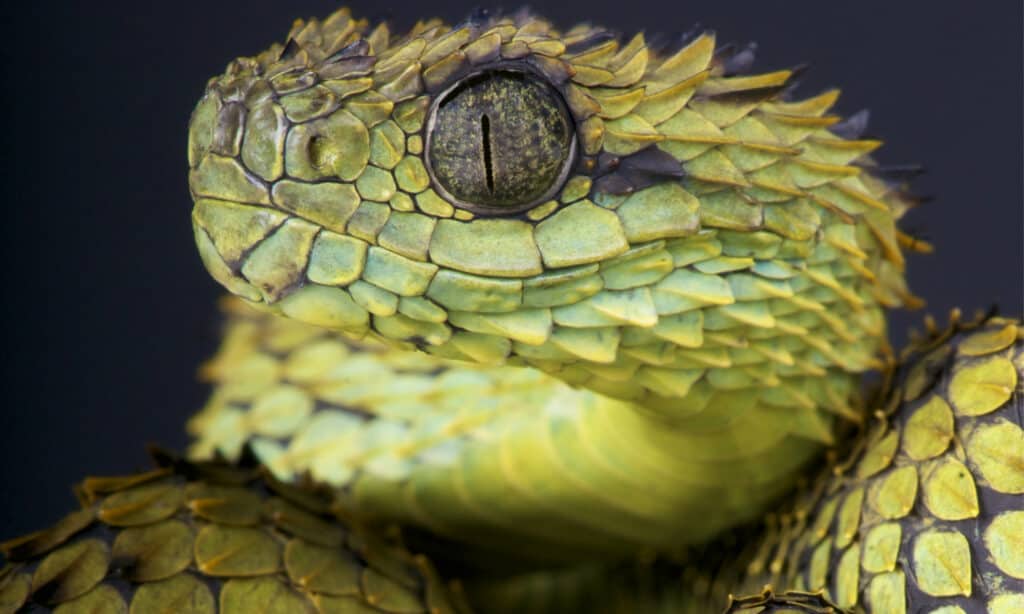
The rough-scaled bush viper is a venomous viper species with large eyes.
©reptiles4all/Shutterstock.com
Atheris hispida is a venomous viper species endemic to Central Africa. It is known for its excessively keeled dorsal scales that give it a bristly appearance. Common names include rough-scaled bush viper, spiny bush viper, and hairy bush viper. These creatures are semi-arboreal, preferring to spend most of their time in trees. Their heads are triangular and broad, with short snouts and eyes with vertically elliptical pupils. The eyes are large and surrounded by 9–16 circumorbital scales. They communicate and perceive heavily through eyesight but also through touch and olfactory senses. The rough-scaled bush viper expands its body and raises the anterior portion of its body into the air when threatened, settling into an attacking position. Their venom is neurotoxic and can cause organ hemorrhage. However, the severity of toxicity varies from person to person.
1. Large-Eyed Green Tree Snake
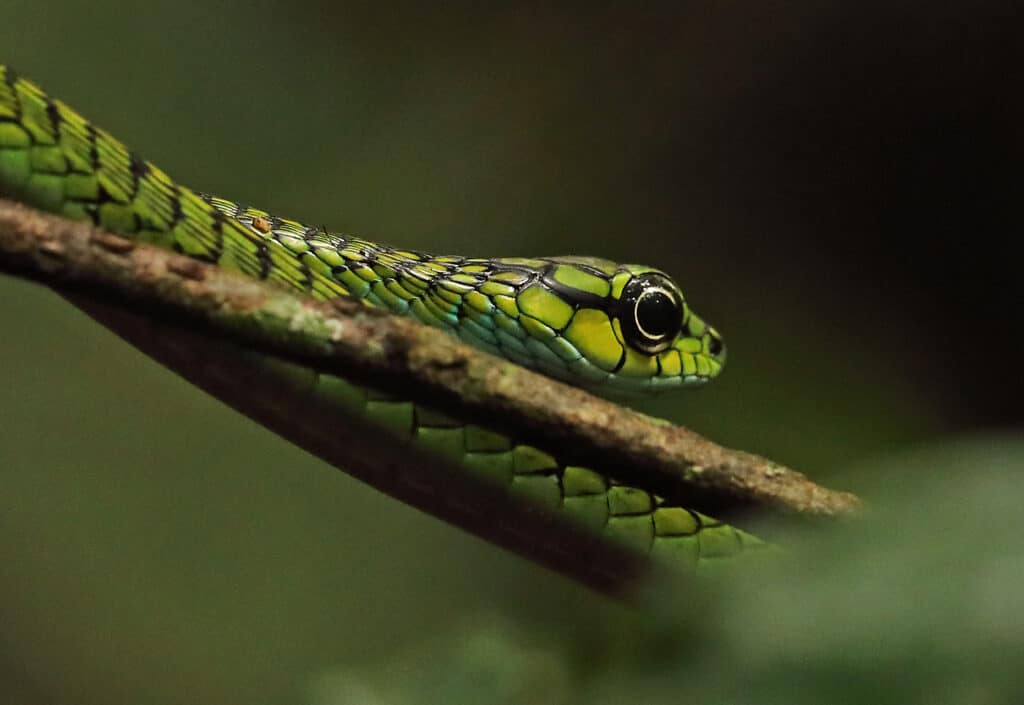
The venomous Large-eyed Green Tree Snake (
Rhamnophis aethiopissa) is endemic to Africa.
©iStock.com/neil bowman
The large-eyed green tree snake (Rhamnophis aethiopissa), also known commonly as the splendid dagger-tooth tree snake, is venomous in the Colubridae family and endemic to Africa. As you might have guessed from their name, green tree snakes are green, but they can also be black and are sometimes even blue. Their necks and bellies are pale golden. The eyes of a green tree snake are likewise more massive than those of most snakes of this size. It’s a colubrid with a rear-fanged tooth and venom, which it may be able to inoculate through biting. Because so little is known about this species and its poison, working with it should be done with extreme caution. This species has a similar defense technique to boomslang and twig snakes, inflating their throat to make themselves appear bigger.
Summary of 10 Snakes With the Biggest Eyes
Let’s review the 10 snakes whose eyes we can’t stop gazing at:
| Rank | Snake | Location |
|---|---|---|
| 1 | Large-Eyed Green Tree Snake | Africa |
| 2 | Rough-Scaled Bush Viper | Central Africa |
| 3 | Southern Whip Snake | Southern Thailand & Myanmar/Peninsular Malaysia & Singapore/ Sumatra and Java |
| 4 | Banded Cat-Eyed Snake | North & South America |
| 5 | Blunt-Headed Tree Snake | Mexico/Central & South America |
| 6 | Big-Eyed Ratsnake | Taiwan/Asia |
| 7 | Yellow-faced Whipsnake | Australia |
| 8 | Large-Eyed Pit Viper | Southeast Asia |
| 9 | Boomslang Snake | Sub-Saharan Africa |
| 10 | Common Big-Eyed Snake | Madagascar |
Which Snake Has the Smallest Eyes?
We have discussed 10 snakes with the biggest eyes in the world – but which snake has the smallest? The Brahminy blind snake is certainly a contender if not the winner in this competition. The Brahminy blind snake (Indotyphlops braminus) is native to Africa and Asia but has been introduced around the world. At first glance, this tiny little snake would appear to be an earthworm, but upon closer inspection, the animal is covered in scales and has no worm-like annular segments. At only 2-4 inches long, the Brahminy blind snake is the world’s smallest snake species. Its eyes are barely visible tiny dots under the head scales. The snake’s eyes are covered with translucent scales that render the animal almost blind, without the ability to form images. It can, however, register light intensity. This little snake lives underground in termite and ant burrows — conveniently within reach of its favorite prey — ants and termites.

As the smallest snake in the world, Brahminy blindsnakes also possess the smallest eyes.
©Radiant Reptilia/Shutterstock.com
The photo featured at the top of this post is ©
Discover the "Monster" Snake 5X Bigger than an Anaconda
Every day A-Z Animals sends out some of the most incredible facts in the world from our free newsletter. Want to discover the 10 most beautiful snakes in the world, a "snake island" where you're never more than 3 feet from danger, or a "monster" snake 5X larger than an anaconda? Then sign up right now and you'll start receiving our daily newsletter absolutely free.
Thank you for reading! Have some feedback for us? Contact the AZ Animals editorial team.






